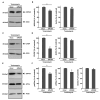Knockdown of Rab9 Recovers Defective Morphological Differentiation Induced by Chemical ER Stress Inducer or PMD-Associated PLP1 Mutant Protein in FBD-102b Cells
- PMID: 39311306
- PMCID: PMC11417737
- DOI: 10.3390/pathophysiology31030032
Knockdown of Rab9 Recovers Defective Morphological Differentiation Induced by Chemical ER Stress Inducer or PMD-Associated PLP1 Mutant Protein in FBD-102b Cells
Abstract
Small GTP-binding proteins of the Rab family regulate intracellular vesicle trafficking across many aspects of the transport system. Among these, Rab9 is recognized for its role in controlling the transport system not only around the trans-Golgi network but also around the late endosome. However, the specific functions across different cell types and tissues remain unclear. Here, for the first time, we report that Rab9 negatively regulates morphological changes in the FBD-102b cell line, an oligodendroglial precursor cell line undergoing morphological differentiation. The knockdown of Rab9 led to an increase in cell shape alterations characterized by widespread membrane extensions. These changes were accompanied by increased expression levels of oligodendroglial cell differentiation and myelination marker proteins. Notably, the knockdown of Rab9 was capable of recovering defective cell morphological changes induced by tunicamycin, an inducer of endoplasmic reticulum (ER) stress, which is one of the major causes of oligodendroglial cell diseases such as Pelizaeus-Merzbacher disease (PMD, currently known as hypomyelinating leukodystrophy type 1 [HLD1]). In addition, Rab9 knockdown recovered levels of ER stress marker proteins and differentiation markers. Similar results were obtained in the cases of dithiothreitol (DTT), another chemical ER stress inducer, as well as HLD1-associated proteolipid protein 1 (PLP1) mutant protein. These results indicate a unique role for Rab9 in oligodendroglial cell morphological changes, suggesting its potential as a therapeutic target for mitigating diseases such as HLD1 at the molecular and cellular levels.
Keywords: ER stress; Rab9; hypomyelinating leukodystrophy; morphogenesis; oligodendrocyte.
Conflict of interest statement
The authors declare no conflicts of interest.
Figures





Similar articles
-
CRISPR/CasRx-Mediated Knockdown of Rab7B Restores Incomplete Cell Shape Induced by Pelizaeus-Merzbacher Disease-Associated PLP1 p.Ala243Val.Neurosci Insights. 2024 Sep 13;19:26331055241276873. doi: 10.1177/26331055241276873. eCollection 2024. Neurosci Insights. 2024. PMID: 39280331 Free PMC article.
-
Knockdown of Rab7B, But Not of Rab7A, Which Antagonistically Regulates Oligodendroglial Cell Morphological Differentiation, Recovers Tunicamycin-Induced Defective Differentiation in FBD-102b Cells.J Mol Neurosci. 2023 Jun;73(6):363-374. doi: 10.1007/s12031-023-02117-y. Epub 2023 May 30. J Mol Neurosci. 2023. PMID: 37248316
-
Hypomyelinating leukodystrophy-associated mutation of RARS leads it to the lysosome, inhibiting oligodendroglial morphological differentiation.Biochem Biophys Rep. 2019 Nov 7;20:100705. doi: 10.1016/j.bbrep.2019.100705. eCollection 2019 Dec. Biochem Biophys Rep. 2019. PMID: 31737794 Free PMC article.
-
Cellular Pathology of Pelizaeus-Merzbacher Disease Involving Chaperones Associated with Endoplasmic Reticulum Stress.Front Mol Biosci. 2017 Feb 24;4:7. doi: 10.3389/fmolb.2017.00007. eCollection 2017. Front Mol Biosci. 2017. PMID: 28286750 Free PMC article. Review.
-
Pelizaeus-Merzbacher Disease: Molecular and Cellular Pathologies and Associated Phenotypes.Adv Exp Med Biol. 2019;1190:201-216. doi: 10.1007/978-981-32-9636-7_13. Adv Exp Med Biol. 2019. PMID: 31760646 Review.
References
-
- Simons N., Pham-Dinh D. Biology of oligodendrocyte and myelin in the mammalian central nervous system. Physiol. Rev. 2001;81:871–927. - PubMed
LinkOut - more resources
Full Text Sources
Research Materials
